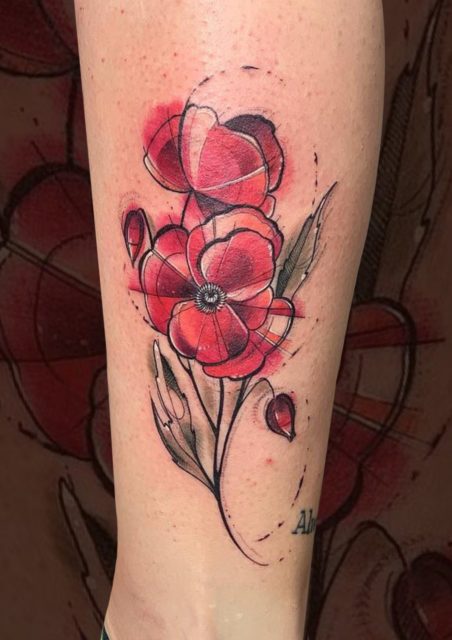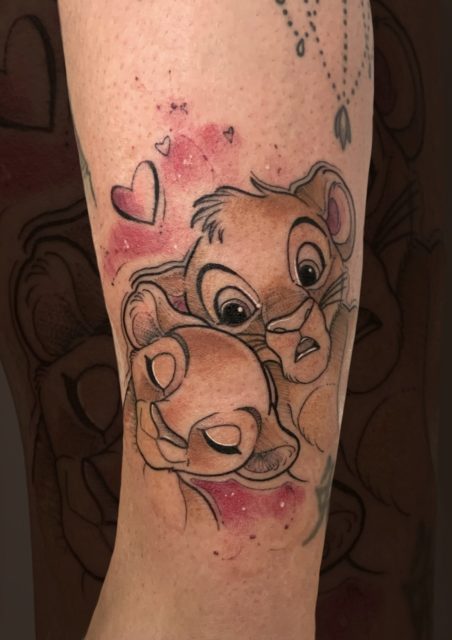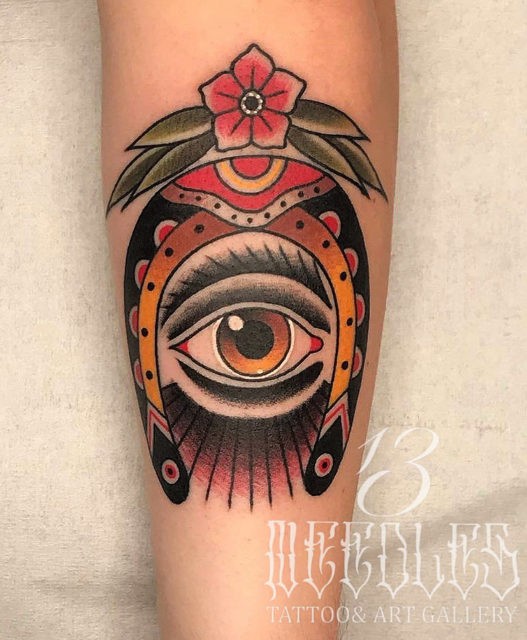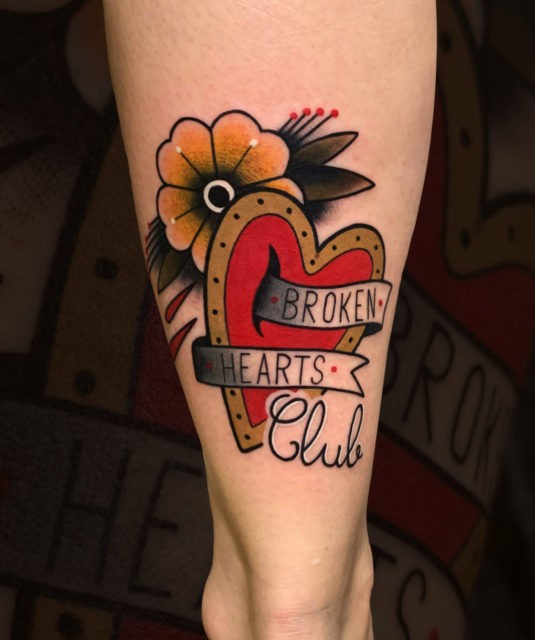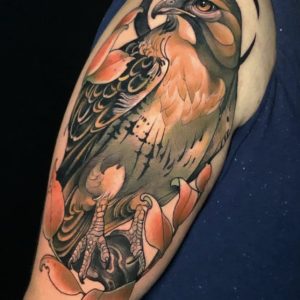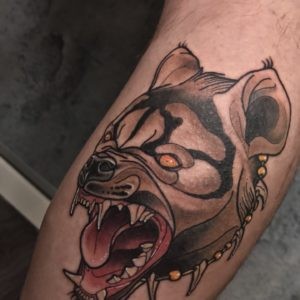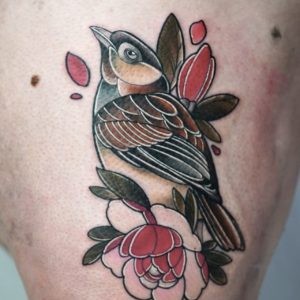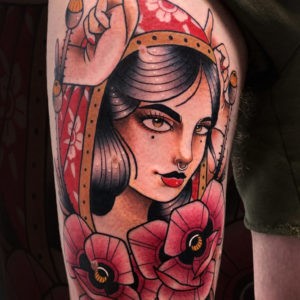STYLE GUIDE
You can get realistic tattoos from Klara and Steward. Attention: Even if the style is the same, the works of both artists are still very different from each other!
Klara works her motifs mainly with black and the color gray. Her works also look healed as if they were freshly tattooed – the gray color does not necessarily make the healed tattoo lighter, just more intense. Stewie, on the other hand, uses “gray-wash” for shading (a black thinned out in different levels, which differs in intensity), which gives the motif a softer, lighter effect in the end. Often the whole thing looks much darker freshly tattooed than it was actually worked in.
Realistic, what exactly is it?
Realism, Realistic or Realism is a tattoo style in which the tattoo should come as close as possible to a real subject.
As a rule, a photo is implemented true to the original and three-dimensional on the skin. The tattoo motifs can be in color or black and gray – almost like a color photo or a black and white picture.
Realistic tattoos are usually as detailed and true to color as possible. In principle, realistic tattoos also have no outlines. By the way, you often see that artists only combine isolated realistic elements with other styles. This gives Realism tattoos a creative touch and looks like more than “just” a photo.
Black & Gray, on the other hand, is a bit broader – the term actually means mainly “in black and different shades of gray” – i.e. without color. This can be implemented in almost any style! Important for realistic tattoos: Give the artist enough freedom in the composition of individual elements. The motifs must have a certain size to look realistic and to be durable. With Black & Gray you have to be able to define a little more – in which style should it actually go?
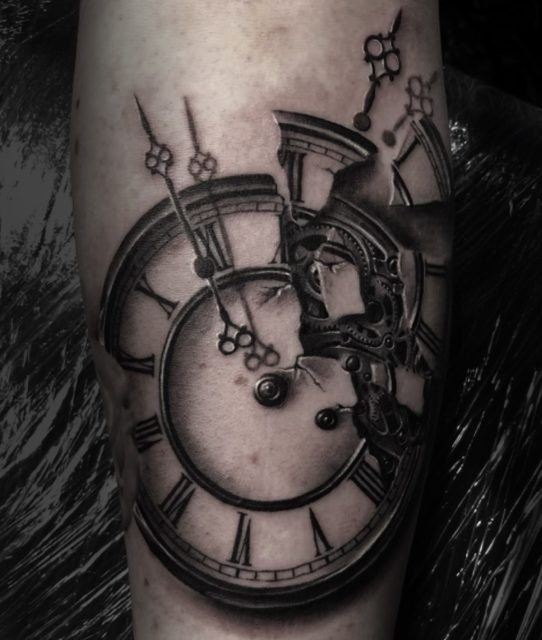
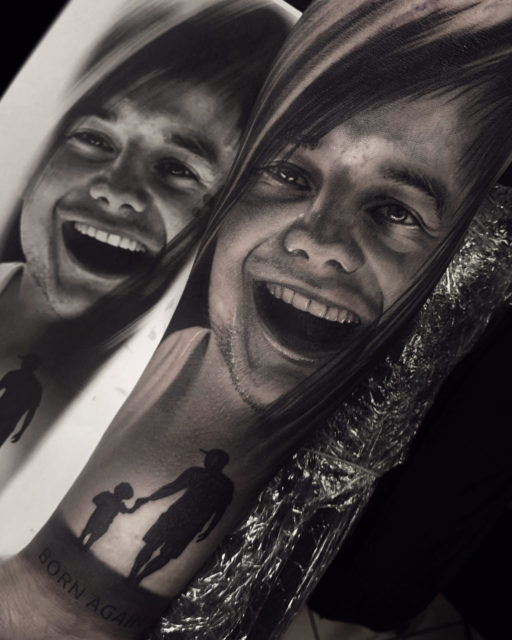
You can only get watercolor or aquarelle tattoos from our owner Jools – Sketched tattoos also mainly from Jools and sometimes from Arnold.
Attention: Even if the style is the same, the works of both artists are still very different from each other!
Jools‘ watercolor motifs are usually available in combination with sketched elements or blackwork motifs. Basically, she does not set any limits here, the main thing is that in the end the whole thing looks coherent and of course simply good. Here Jools works almost exclusively freehand – so you have to trust it almost blindly. Watercolor lives from depth and lightness, i.e. instead of a rainbow one should rather commit to 1-2 main colors, which are worked out in different nuances.
Sketchwork motifs, on the other hand, are always a combination of thicker and very fine lines. Here, too, you usually get to see the motif beforehand, but where it is precisely sketched and hatched at the end is always a surprise and thus makes every motif a special experience.
Watercolor, what exactly is it?
Watercolor or aquarelle tattoos have become very popular, especially within the last few years. As the name suggests, this style is about making the tattoo look like it was painted with watercolors or ink. Often you will find soft color gradients, color bleeding, brush strokes, blobs or drops in these tattoos.
Sketchy, Sketched, Sketchwork …
there are many terms for this. “Sketched” is the name given to tattoos that resemble a typical pencil sketch. Lines can also be imperfect and incomplete. A sketchy motif can, for example, still contain orientation lines as a stylistic device or be cross-hatched.
Important for watercolor tattoos: Give the artist enough freedom in the composition and the interplay of colors and surfaces. Less is more – individual colors can achieve far more effects than a whole color box. With sketched tattoos you should make sure that the artist can draw fine lines and here, too, the best thing to do is: just let it be done.
You get oldschool / traditional mainly from owner Jools and resident guest Mario, for neo-traditional tattoos you have a lot of choice with us – Lorena, Arnold, now and then Jools and our resident guest Gino embody this style at 13 Needles.
Attention: Even if the style is the same, the works of all artists are still very different from each other!
Lorena‘s neo-traditional has a strong Art Nouveau influence. Her often very feminine works are framed by flowers or curved decorations. She prefers to tattoo portraits of women or animals – these have her unmistakably creative touch. When it comes to choosing colors, Lorena usually sticks to one scheme: lots of yellow and orange, warm and rather less different tones. Arnold, on the other hand, is more open in his choice of colors, but also very earthy – he attaches great importance to his creative influence on the motif and is happy about mythological and occult motifs or animals of any kind. You will find many delicate details in his work. If you want a neo-traditional motif from Jools you will see a clear difference to our other artists – the traditional influence is unmistakable with her, her motifs have a mix of very thick and rich, but also fine lines – as well as intense color combinations. Her traditional motifs also usually have a very individual note, a larger color palette than usual in this style and, despite thick lines, also small, fine details.
But traditional, what is it actually?
Traditional tattoos are deeply rooted in the history of tattooing. These traditional tattoos are particularly rooted in seafaring, which is why they are often referred to as “sailor tattoos”.
The classic old school motifs include, for example, swallows, anchors, dragons, ships, snakes, skulls, eagles or panthers.
What distinguishes this style quickly becomes clear when you look at the corresponding work: The motifs always have thick black outlines and rich colors, but often a very small color palette.
And Neo-Traditional?
Neotraditional is a kind of reinterpretation of the traditional tattoo style. In contrast to the traditional, the color palette in the neotraditional is very broad. In addition, the motifs can be very detailed, often consisting of a combination of thick and thin outlines.
Often you can also see an influence of Art Nouveau or Art Deco in this style.
Important for both styles: traditional tattoos live from clean, thick lines and “scratchy” shades. They should sit! With neo-traditional, in our opinion, it is important to give the artist a lot of freedom in the design and expansion or “decoration” of the desired motif.
Important for both styles: traditional tattoos live from clean, thick lines and “scratchy” shades. They should sit! With neo-traditional, in our opinion, it is important to give the artist a lot of freedom in the design and expansion or “decoration” of the desired motif.
At 13 Needles, owner Jools, Resident Arnold and Resident Guest Gino are mainly your “Artists of Choice” for blackwork / fineline tattoos.
Attention: Even if the style is the same, the works of both artists are still very different from each other!
Jools likes to use sketchy elements in a combination of thick and fine, clear lines, her blackwork motifs are often with whip shading (the needles “hop” over the skin at ever greater intervals and thus form a point-like course from dark to light ) – she attaches great importance to clean lines and is very meticulous.
Arnold and Gino like to keep their motifs delicate and clear, which they then often additionally shade in a classic, mostly light shade. The blackwork motifs of the two basically have a neo-traditional influence.
But blackwork, what is it actually?
In general, tattoos are referred to as blackwork if the artist has only used black ink. The designs can differ greatly in style. That is why you can find almost everything under Blackwork, from ornaments and geometries to very finely detailed illustrations.
Fineline is the name given to tattoos that consist of very filigree and fine lines.
But be careful: we work on skin, not on paper. If the lines are too fine, they may partially disappear or fade heavily.
It is therefore particularly important that the motifs are not engraved too small or too detailed.
Important for both style directions: Make sure that your artist can draw clear, clean lines. This is usually decisive for the overall effect of the motif in the end!
Important for both styles: traditional tattoos live from clean, thick lines and “scratchy” shades. They should sit! With neo-traditional, in our opinion, it is important to give the artist a lot of freedom in the design and expansion or “decoration” of the desired motif.
Important for both style directions: Make sure that your artist can draw clear, clean lines. This is usually decisive for the overall effect of the motif in the end!
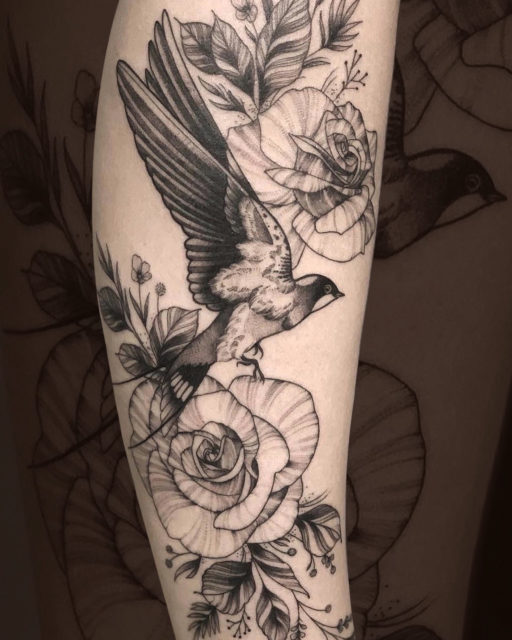
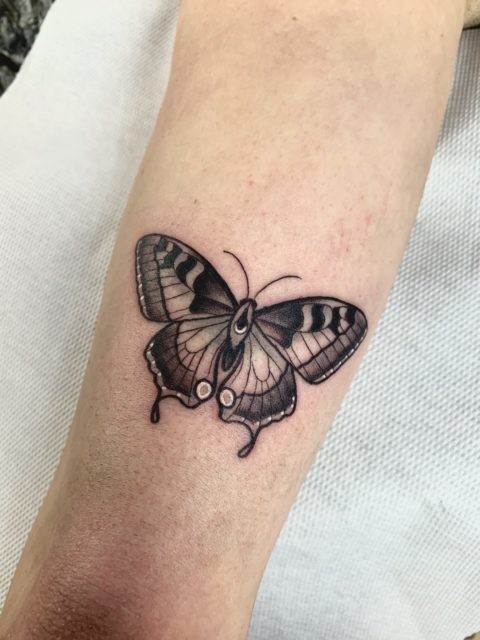
You get mandalas and geometric tattoos with us mainly from our resident guest Justin, from boss Jools or resident guest Gino. For mandala / geometry sleeves and large projects, however, you are best off with Justin.
Justin‘s mandalas usually have many tips, skilfully used black surfaces and small-scale details – Jools‘ mandalas, on the other hand, are softer and more feminine, not too small-scale and often worked in combination with dotwork.
Geometric tattoos are characterized by the use of geometric shapes. In addition to classic shapes such as triangles and circles, this also includes unusual patterns, also known as “patterns”.
The principle is similar with mandalas; precise placement of the motif is also important here so that the mainly round shape does not distort too much.
Remember: your body is not a straight sheet of paper – you and your artist should look together for the right placement and consider whether the whole thing works.
Of course, it is particularly important in this style that the artist works “cleanly”, i.e. with perfect lines. A geometric tattoo or mandala can only achieve the desired effect with straight and even lines.
Remember: your body is not a straight sheet of paper – you and your artist should look together for the right placement and consider whether the whole thing works.
Of course, it is particularly important with geometric tattoos that the artist works “cleanly”, i.e. with perfect lines. Because only with straight and even lines can a geometric tattoo or mandala achieve the targeted effect.
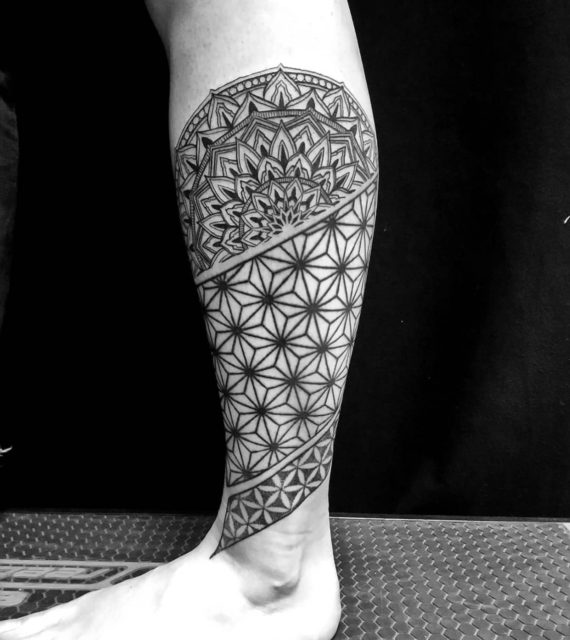
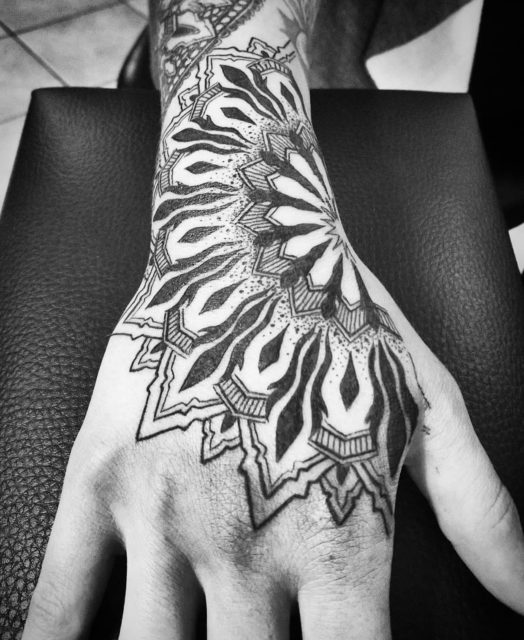
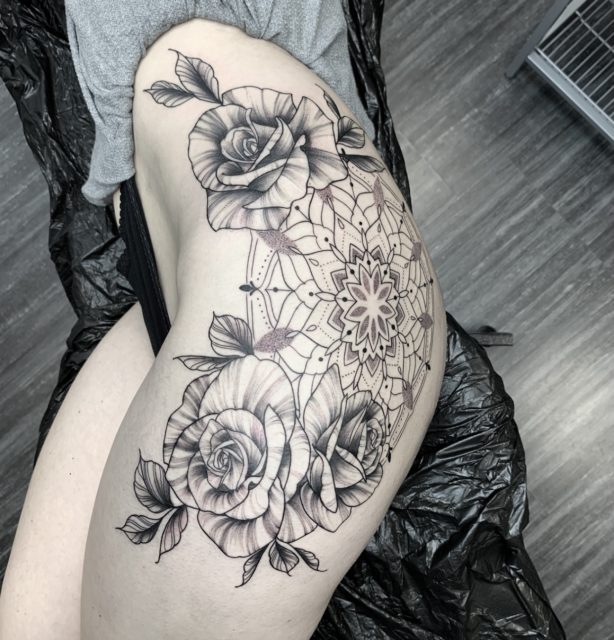
You can get scripts from every artist equally well with us. However, it is important to distinguish here again, because lettering is not just “small script”! Whether I want a fine “live, laugh, love” script on the wrist or an ornate LA FAMILIA lettering over the entire forearm – it can make a huge difference – you should definitely differentiate here!
Whether freehand or designed for you in advance: you can get a real lettering tattoo from Resident Steward. A lettering consists of a lot more things than just the letters – they are often worked out accordingly with ornamental decorations, shadows and various highlights.
Tattooing such lettering is nowhere near as simple as the origin of the word! We recommend that you look for a tattoo artist who specializes in such a tattoo.
With a lettering tattoo, it is important that the lettering is also adapted to the respective part of the body.
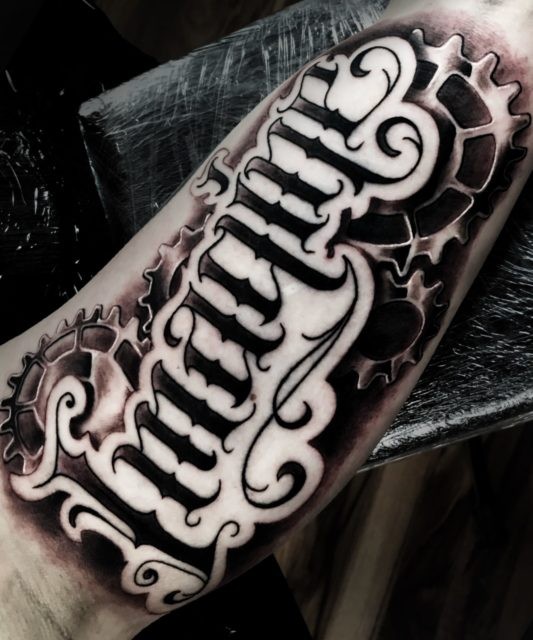
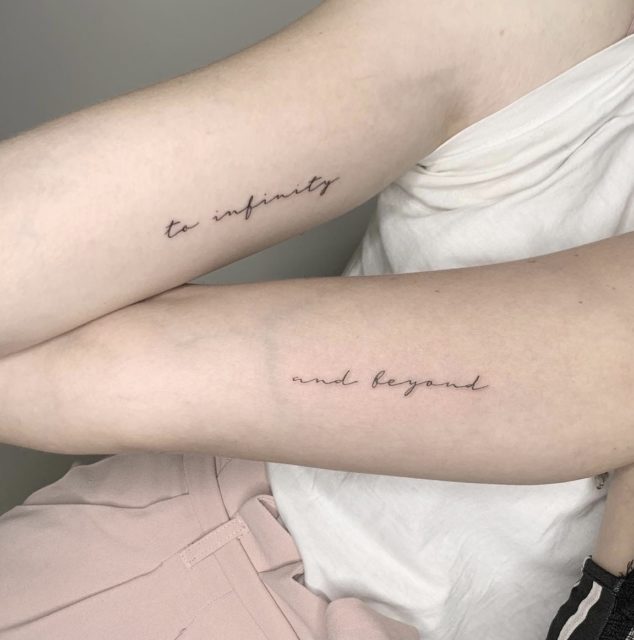
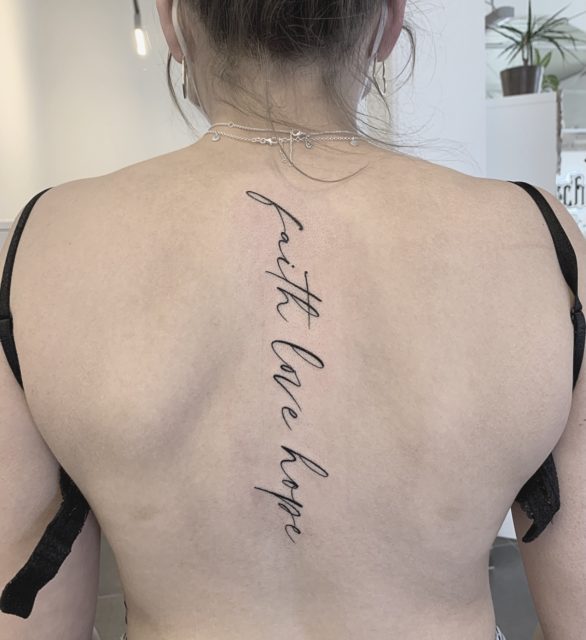
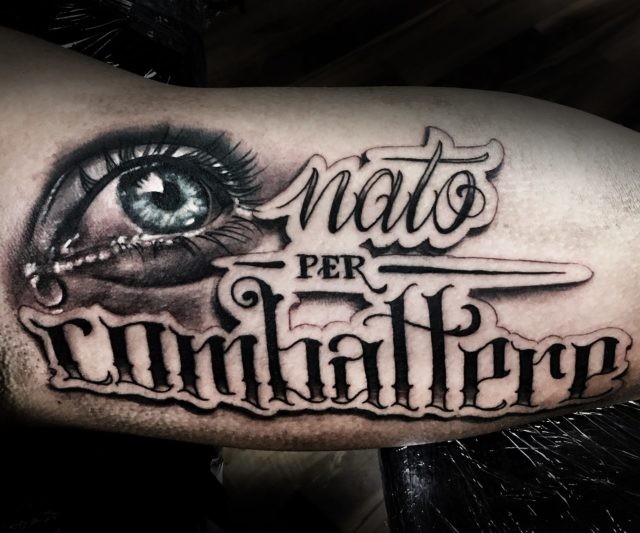
You get dotwork tattoos with us mainly from boss Jools, resident guest Justin and resident guest Gino.
Dotwork
Dotwork is all about one thing: Dots – and a lot of them. Here entire motifs consist only of points or are shaded with points over and over again.
There are also various gimmicks, often in combination with mandalas – very special effects can be created by dotting from dark to light.
The way in which the dots are thick or fine can also be used as a stylistic tool here – while Justin works exclusively with fine, black dots, for example, you often see “color gradients” from dark to light or combinations of light and dark at Jools Points.
The way in which the dots are thick or fine can also be used as a stylistic tool here – while Justin, for example, works exclusively with fine, black dots, at Jools you often see “color gradients” from dark to light or combinations of light and dark Dots.
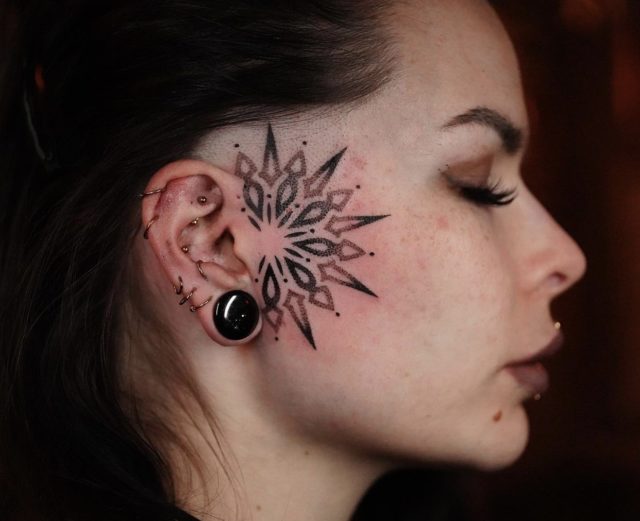
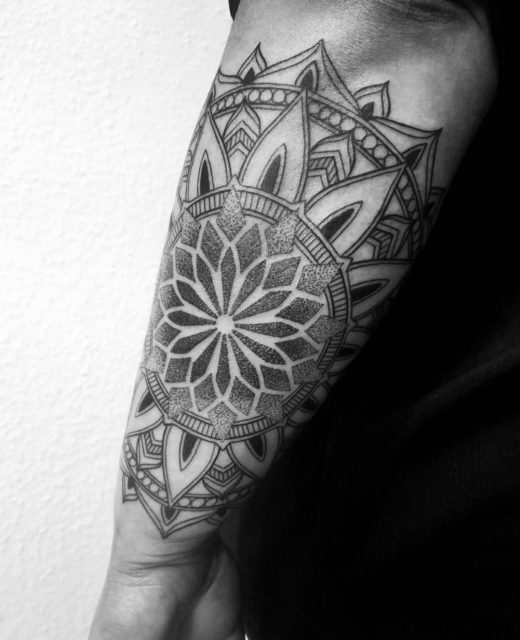
You get Japanese tattoos with us mainly from Resident Guest Mario, Resident Guest Gino, Resident Arnold or Resident Guest Lorena. It is important to differentiate here, because the styles of all three artists are very different. Anyone who thinks of classic Japanese traditional is definitely at the right address with Mario. If it should be stylized a bit more unusual, Gino, Arnold and Lorena would be a good alternative.
Japanese tattoos, also known as irezumi are traditional Japanese tattoos. These tattoos originally come from the Edo period, where they tended to inspire the working class in Japan. From 1720 onwards, tattoos were used in Japan as a kind of branding for criminals (and often associated with the Japanese mafia) and tattoos acquired a very negative connotation. In fact, tattoos were completely banned in Japan until 1948.
The motifs often come from mythology, legends, symbolism or the history of the country.
In terms of style, Japanese tattoos are primarily characterized by clear colors and a wealth of details.
Even today, tattoos in Japan are still stigmatized and associated with crime and are sometimes not welcomed.
Because Japanese / Asian motifs have so much meaning in them, it is important to have an artist who is familiar with the history and anthology. For example, a koi swimming upwards can have a very different meaning than a koi swimming downwards. Please do some research beforehand or discuss your wishes with an experienced artist.
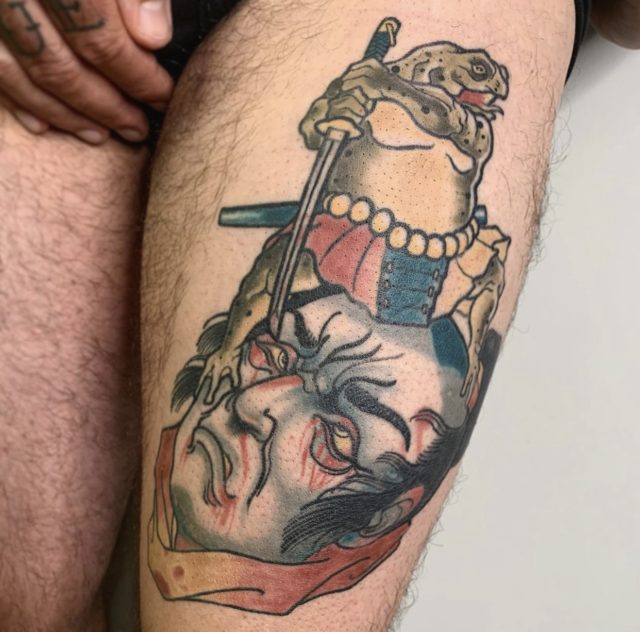
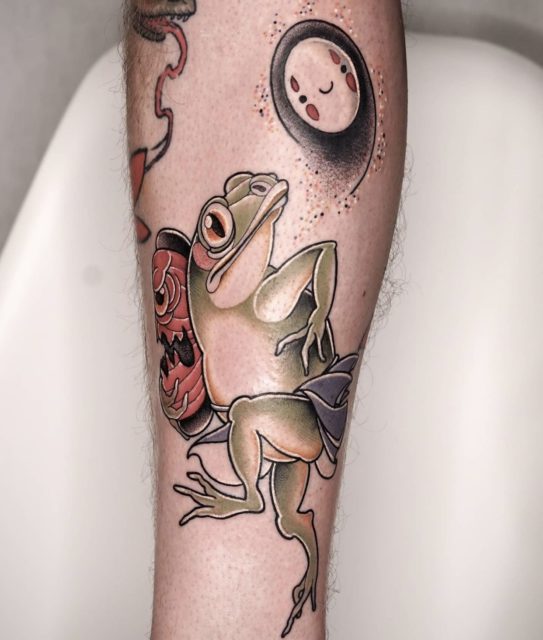
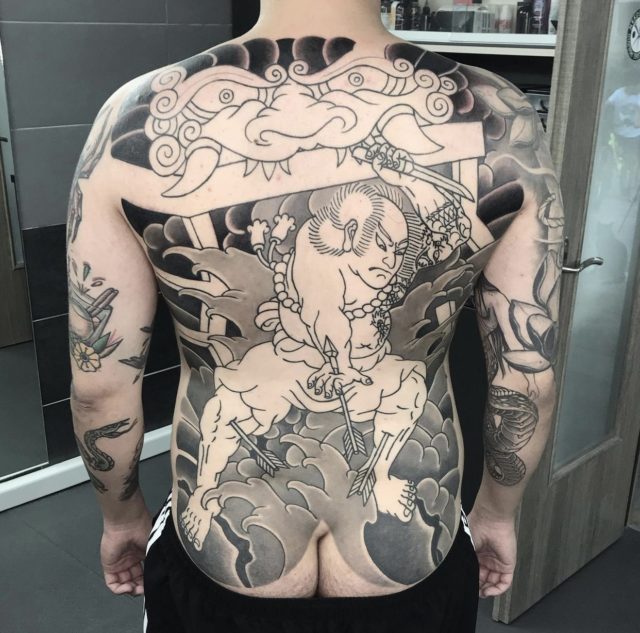
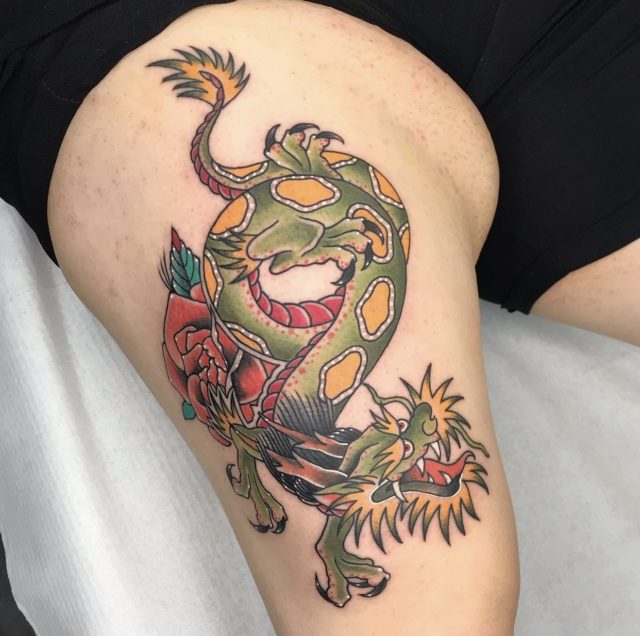
There are clear differences between comics, new school and kawaii, even if they are often lumped together. You get comic & new school tattoos with us mainly from boss Jools and resident Steward. Jools‘ New School is very comic, playful, while Stewards New School is very realistic and dimensional. You can only get kawaii tattoos from Jools.
New School gained popularity in the 80s and 90s. The “new school” mainly includes thick outlines and very lively, bright colors. Another aspect of this style is the very exaggerated, silly or crazy representation of the chosen subject. So it is not surprising that New School tattoos are often reminiscent of cartoons, graffiti or caricatures.
“Kawaii” originally comes from Japanese and means something like sweet or lovable.
Conspicuous features of these motifs are, for example, the big eyes of the trivialized representations, asterisks, hearts, generally kitsch – as well as pastel colors and glitter.
Here, too, it is important to give the artists enough freedom in the layout and, above all, in the choice of colors – these styles live from being colorful and “crazy”.
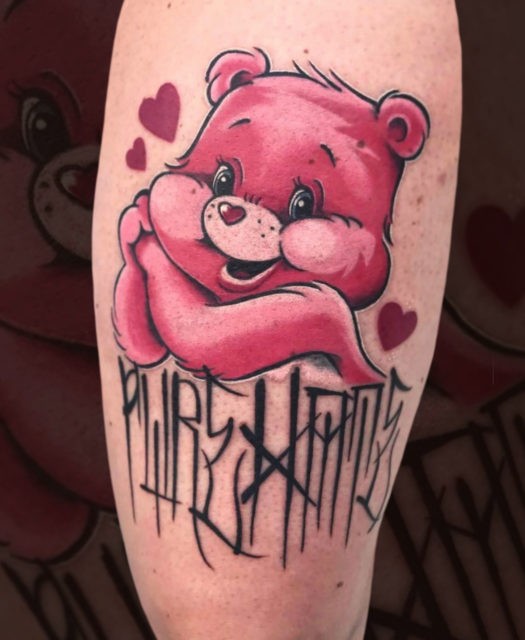
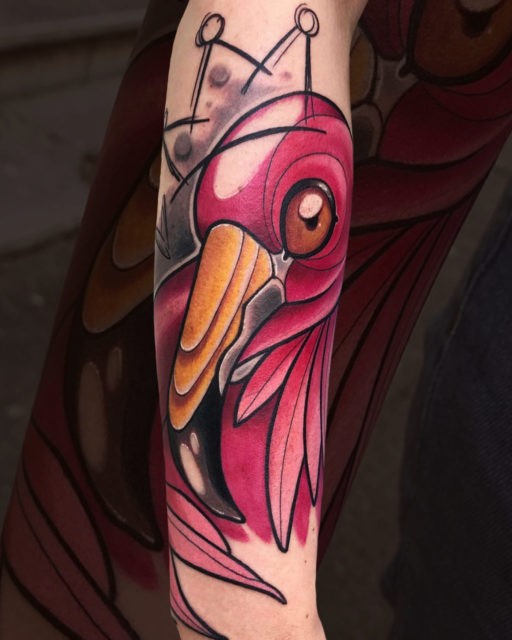
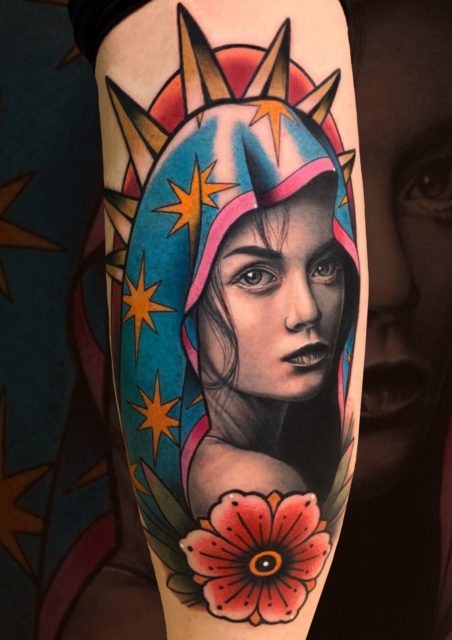
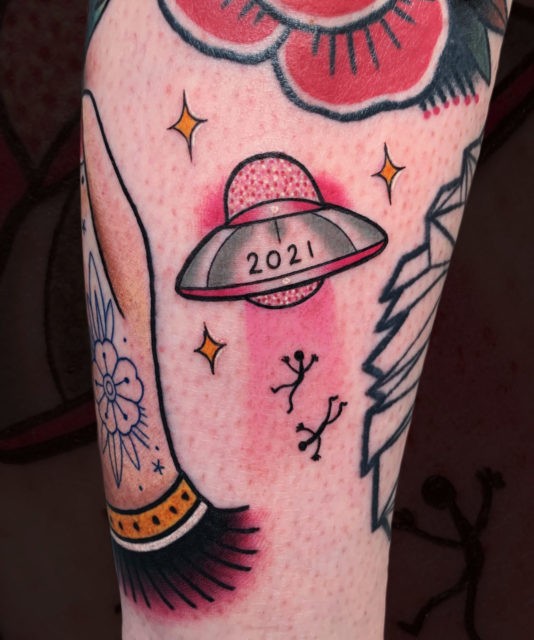
With us you can get single-line tattoos equally well done by every artist. We do not offer hand-poked tattoos in our shop.
But what do these terms actually mean?
The special thing about single-line or one-line tattoos is that they actually only consist of a single line and are therefore rather minimalistic.
With this style, it is important that every line fits one hundred percent – because there is only one.
Hand-poked are tattoos that are not made with a machine. Instead, the tattoo artist only uses a tattoo needle and, if necessary, a handle to work in the tattoo color.
With this type of tattooing, the artist really brings the motif into the skin point by point. Compared to machine tattoos, however, this method is significantly more time-consuming.
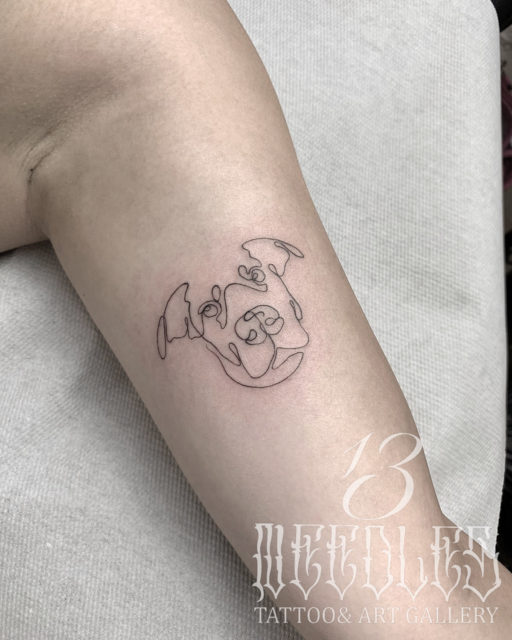
Collaborations are a Tattoo made by 2 or more tattoo artists. A collaboration requires a certain amount of planning in advance, these work best when you skillfully combine two different styles, e.g. Realistic and Traditional.
There are basically no limits: Whether a photo-realistic face in combination with traditional decor, a realistic tiger with a watercolor background, or or or … our artists can get creative here and combine the best features of both styles to make something incredibly interesting and unique.
With us you get collaborations on request, so far Jools & Klara and Jools & Lorena had the pleasure of designing and tattooing a project together.
If you are interested in such a collaboration, please plan a personal conversation with both artists and discuss the possibilities together. Here, too, as with almost everything, it is incredibly important for both artists to create enough freedom to act out – combinations in particular require a lot of know-how and leeway.
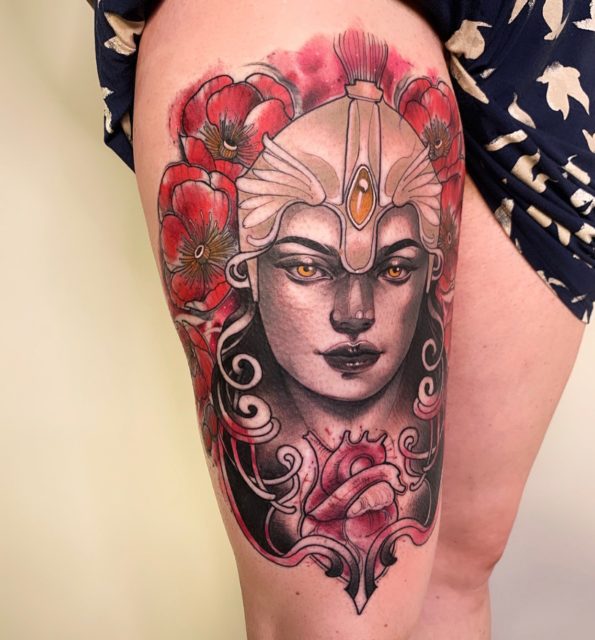

Any questions left?
Contact
Phone: +49 (0) 6 11 / 88 00 56 00
E-Mail: info@13needles.de
13 Needles Tattoo & Art Gallery
Rheinstraße 85
65185 Wiesbaden
